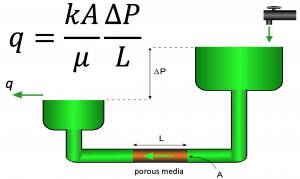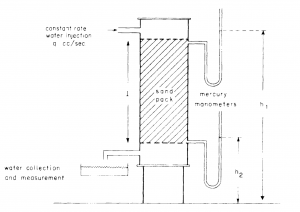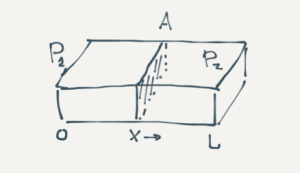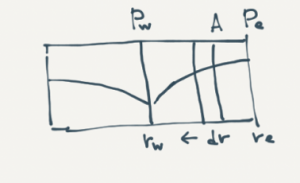Difference between revisions of "Darcy's law"
(Created page with "== Brief == Real Gas is a gas whose molecules occupy space and have interactions [https://en.wikipedia.org/wiki/Real_gas]. Real Gas deviates from Ideal Gas by pr...") |
(→See Also) |
||
| (138 intermediate revisions by the same user not shown) | |||
| Line 1: | Line 1: | ||
| − | == | + | == Darcy's law == |
| − | [[ | + | [[File:Darcy's law.png|thumb|right|300px| Darcy's law. Equation and notations]] |
| − | [[ | + | [[Darcy's law]] is the fundamental '''law''' of fluid motion in porous media published by '''Henry Darcy''' in '''1856''' <ref name=Darcy/>. French engineer '''Henry Darcy''' has earned himself a special place in history as the first experimental reservoir engineer <ref name=DakeF/>. |
| − | + | [[Darcy's law]] has been successfully applied to determine the flow through permeable media since the early days of [[Petroleum Engineering]]. | |
| − | The [[ | + | The basic form of [[Darcy's law]] is very similar to in form to other physical laws. For example '''Fourier's law''' for heat conduction and '''Ohm's law''' for flow of electricity <ref name=DW/>. |
| − | :<math> | + | [[Darcy's law]] formula: |
| + | :<math>q=\frac{kA}{\mu} \frac{\Delta P}{L}</math> | ||
| − | + | where | |
| − | :<math> | + | :<math> A </math> = cross-sectional area, cm<sup>2</sup> |
| − | :<math> | + | :<math> k</math> = permeability, Darcy |
| − | :<math> | + | :<math> L </math> = length, cm |
| − | :<math> P </math> = | + | :<math> P </math> = pressure, atm |
| − | :<math> | + | :<math> q </math> = flow rate, cm<sup>3</sup>/sec |
| − | + | :<math> \mu </math> = fluid viscosity, cp | |
| − | |||
| − | :<math> | ||
| − | === | + | The permeability of 1 Darcy defined as permeability which allows fluid with viscosity of 1 centipoise flow a distance of 1 cm with velocity of 1 cc/sec through the crossectional area of 1 cm2 with the pressure gradient of 1 atm. |
| − | [[ | + | |
| − | [[ | + | ==Example== |
| − | [[ | + | Determine the water phase permeability given the core lab test data: |
| − | [[ | + | 100% water saturation, A=2.5 cm2, L=3 cm, qw=0.6 cm3/sec, dP=2 atm, water viscosity 1 cP. |
| + | |||
| + | :<math>k=\frac{q \mu L}{A \Delta P} = \frac{0.6 *1 *3}{2*2.5}=0.360\ Darcy</math> | ||
| + | |||
| + | ==History == | ||
| + | [[File:Darcy's experimental equipment.png|thumb|right|300px| Darcy's experimental equipment]] | ||
| + | |||
| + | '''Henry Darcy''' worked on the design of a filter large enough to process the Dijon towns daily water requirement <ref name=DakeF/>. | ||
| + | |||
| + | By flowing water through the sand pack Darcy established that, for any flow rate, the velocity of the flow was directly proportional to the difference in manometric heights<ref name=DakeF/>: | ||
| + | |||
| + | :<math>u=K\frac{h1-h2}{L}</math> | ||
| + | |||
| + | All the experiments were carried out with water changing the type of sand pack. The effects of fluid density and viscosity on the flow was not investigated<ref name=DakeF/> and therefore accounted for in the constant '''K'''. | ||
| + | |||
| + | Subsequently, others experiments performed with a variety of different liquids revealed the dependence of fluid flow on fluid density and viscosity. | ||
| + | |||
| + | The new constant '''k''' has therefore been isolated as being solely dependent on the nature of sand and is described as the '''permeability'''<ref name=DakeF/>. | ||
| + | |||
| + | == Equation == | ||
| + | ===Differential form === | ||
| + | If distance is measured positive in the direction of flow, then the pressure gradient must be negative in the same direction since fluids move from high to low pressure<ref name=DakeF/>. Therefore, Darcy's law is: | ||
| + | |||
| + | :<math> q = -\frac{kA}{\mu} \frac{dP}{dL}</math> | ||
| + | ===Linear form=== | ||
| + | :<math> q = \frac{k}{\mu} \frac{A}{L} (P_1 - P_2)</math> [[File:Darcy's Law Linear form equation.png|300px| Darcy's Law Linear form equation notation]] | ||
| + | |||
| + | ===Radial form=== | ||
| + | :<math> q = \frac{2 \pi kh (P_e - P_w)}{\mu ln(r_e/r_w)}</math> [[File:Darcy's Law Radial form equation.png|300px| Darcy's Law Radial form equation notation]] | ||
| + | |||
| + | === Conditions === | ||
| + | |||
| + | *Single fluid | ||
| + | *Steady stay flow | ||
| + | *Constant fluid compressibility | ||
| + | *Constant temperature | ||
| + | |||
| + | == Inflow Equations Derivation == | ||
| + | |||
| + | Derivation of the Linear and Radial Inflow Equations | ||
| + | [[File:Darcy's Law mtuz.png|800px]] | ||
| + | |||
| + | ==See Also== | ||
| + | |||
| + | * [[IPR]] | ||
| + | * [[141.2 derivation]] Converting from the Darcy's law units to the field units in the well's inflow equations | ||
| + | * [[18.41 derivation]] Converting from the Darcy's law units to the metric units in the well's inflow equations | ||
| + | * Calculating [[Production Potential]] with the [[Darcy's law]] | ||
| + | * [[Petroleum Engineering]] | ||
| + | * [[Relative Permeability]] | ||
| + | * [[JD]] | ||
| + | * [[Productivity index|J]] | ||
| + | |||
| + | ==References== | ||
| + | |||
| + | <references> | ||
| + | |||
| + | <ref name=Darcy>{{cite journal | ||
| + | |last1=Darcy|first1= Henry | ||
| + | |title=Les Fontaines Publiques de la Ville de Dijon | ||
| + | |publisher=Victor Dalmont | ||
| + | |date=1856 | ||
| + | |place=Paris | ||
| + | |url=https://books.google.ru/books?id=-FxYAAAAYAAJ&printsec=frontcover&hl=ru&source=gbs_ge_summary_r&cad=0#v=twopage&q&f=false | ||
| + | }}</ref> | ||
| + | |||
| + | <ref name=DakeF>{{cite book | ||
| + | |last1= Dake |first1=L.P. | ||
| + | |title=Fundamentals of Reservoir Engineering | ||
| + | |date=1978 | ||
| + | |publisher=Elsevier Science | ||
| + | |place=Amsterdam, Hetherlands | ||
| + | }}</ref> | ||
| + | |||
| + | <ref name=DW> | ||
| + | {{cite book | ||
| + | |last1= Wolcott |first1=Don | ||
| + | |title=Applied Waterflood Field Development | ||
| + | |date=2009 | ||
| + | |publisher=Energy Tribune Publishing Inc | ||
| + | |place=Houston | ||
| + | |url=https://www.amazon.com/Applied-Waterflood-Field-Development-Wolcott/dp/0578023946/ref=sr_1_1?ie=UTF8&qid=1481788841&sr=8-1&keywords=Don+wolcott | ||
| + | |url-access=subscription | ||
| + | }}</ref> | ||
| + | |||
| + | </references> | ||
[[Category:E&P Portal]] | [[Category:E&P Portal]] | ||
| + | [[Category:pengtools]] | ||
| + | [[Category:Mature Water Flood Analysis]] | ||
| + | |||
| + | {{#seo: | ||
| + | |title=Darcy's law | Equation Formula Examples | Petroleum Engineering | ||
| + | |titlemode= replace | ||
| + | |keywords=Darcy's law equation | ||
| + | |description=Darcy's law equation, history, examples, derivation and applications in petroleum engineering. | ||
| + | }} | ||
Latest revision as of 18:25, 4 April 2025
Contents
Darcy's law
Darcy's law is the fundamental law of fluid motion in porous media published by Henry Darcy in 1856 [1]. French engineer Henry Darcy has earned himself a special place in history as the first experimental reservoir engineer [2].
Darcy's law has been successfully applied to determine the flow through permeable media since the early days of Petroleum Engineering.
The basic form of Darcy's law is very similar to in form to other physical laws. For example Fourier's law for heat conduction and Ohm's law for flow of electricity [3].
Darcy's law formula:
where
 = cross-sectional area, cm2
= cross-sectional area, cm2 = permeability, Darcy
= permeability, Darcy = length, cm
= length, cm = pressure, atm
= pressure, atm = flow rate, cm3/sec
= flow rate, cm3/sec = fluid viscosity, cp
= fluid viscosity, cp
The permeability of 1 Darcy defined as permeability which allows fluid with viscosity of 1 centipoise flow a distance of 1 cm with velocity of 1 cc/sec through the crossectional area of 1 cm2 with the pressure gradient of 1 atm.
Example
Determine the water phase permeability given the core lab test data: 100% water saturation, A=2.5 cm2, L=3 cm, qw=0.6 cm3/sec, dP=2 atm, water viscosity 1 cP.
History
Henry Darcy worked on the design of a filter large enough to process the Dijon towns daily water requirement [2].
By flowing water through the sand pack Darcy established that, for any flow rate, the velocity of the flow was directly proportional to the difference in manometric heights[2]:
All the experiments were carried out with water changing the type of sand pack. The effects of fluid density and viscosity on the flow was not investigated[2] and therefore accounted for in the constant K.
Subsequently, others experiments performed with a variety of different liquids revealed the dependence of fluid flow on fluid density and viscosity.
The new constant k has therefore been isolated as being solely dependent on the nature of sand and is described as the permeability[2].
Equation
Differential form
If distance is measured positive in the direction of flow, then the pressure gradient must be negative in the same direction since fluids move from high to low pressure[2]. Therefore, Darcy's law is:
Linear form
Radial form
Conditions
- Single fluid
- Steady stay flow
- Constant fluid compressibility
- Constant temperature
Inflow Equations Derivation
Derivation of the Linear and Radial Inflow Equations
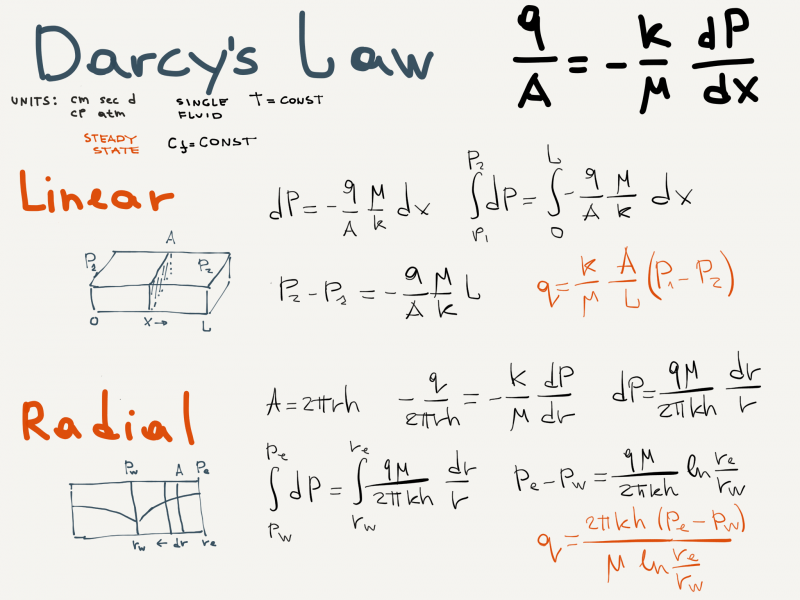
See Also
- IPR
- 141.2 derivation Converting from the Darcy's law units to the field units in the well's inflow equations
- 18.41 derivation Converting from the Darcy's law units to the metric units in the well's inflow equations
- Calculating Production Potential with the Darcy's law
- Petroleum Engineering
- Relative Permeability
- JD
- J
References
- ↑ Darcy, Henry (1856). "Les Fontaines Publiques de la Ville de Dijon". Paris: Victor Dalmont.
- ↑ 2.0 2.1 2.2 2.3 2.4 2.5 Dake, L.P. (1978). Fundamentals of Reservoir Engineering. Amsterdam, Hetherlands: Elsevier Science.
- ↑
Wolcott, Don (2009). Applied Waterflood Field Development
 . Houston: Energy Tribune Publishing Inc.
. Houston: Energy Tribune Publishing Inc.
